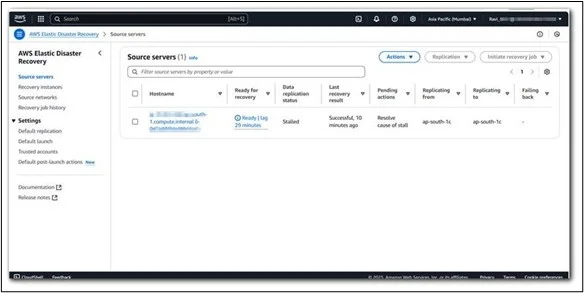|
Voiced by Amazon Polly |
Overview
Your on-premises or cloud-based applications on AWS can be swiftly and minimally disrupted and recovered with AWS DRS. We will show you how this service allows replication, failover, and failback procedures to run smoothly, guaranteeing a dependable, automated disaster recovery process that eliminates the need for intricate manual intervention. This post will discuss the AWS DRS service and how it reduces data loss and downtime during unplanned outages or failures.
Pioneers in Cloud Consulting & Migration Services
- Reduced infrastructural costs
- Accelerated application deployment
Introduction
AWS Elastic Disaster Recovery (AWS DRS) is a fully managed service that enables businesses to recover on-premises and cloud-based apps quickly and reliably while reducing downtime and data loss. In the case of a disaster, such as a hardware malfunction, ransomware attack, or natural disaster, it allows you to swiftly recover AWS workloads by replicating source servers at the block level. By automating replication, failover, and failback, AWS DRS streamlines conventional disaster recovery procedures and enables enterprises to preserve high availability and resilience without dealing with the hassles of managing specialized DR infrastructure.
Key Components of AWS DRS
- Source Server
This is the original server (physical, virtual, or cloud-based) you want to protect using AWS DRS. It runs your production workloads and applications. You install the AWS Replication Agent on it so AWS DRS can continuously replicate its data to AWS.
- Replication Server
AWS DRS created and managed a temporary Amazon EC2 instance during data replication. It receives the replicated data from the source server and writes it to Amazon EBS volumes in the staging area subnet. Automatically provisioned and terminated by AWS as needed. You do not manage it directly.
- Conversion Server
A temporary Amazon EC2 instance is used only during recovery (or drill). It converts the replicated disks into bootable volumes for use with Amazon EC2 instances. Created during the recovery process and terminated automatically after the conversion was completed.
- Recovery Server
This is the Amazon EC2 instance launched in AWS as a recovered version of your source server. It runs your application in AWS during a failover, drill, or actual recovery. Used in recovery drills, real disasters, or planned migration.
Implementation Steps
Step 1: Set Up AWS Elastic Disaster Recovery
- Log in to the AWS Management Console.
- Navigate to AWS Elastic Disaster Recovery.
- Click “Get Started” or “Set up disaster recovery”.
Step 2: Configure Replication Settings
- Choose the default replication settings or customize them:
- Staging area subnet (in your target region).
- Security groups, instance types, data routing options, and encryption.
Step 3: Add Source Server and Install Replication Agent
- The list of servers is protected in the Source Servers tab.
- Download and install the AWS Replication Agent on your source machine.
- Once installed, the server will appear in the DRS console.
Source Server

Agent Installed

Step 4: Launch a Recovery Instance and Monitor Recovery Job Logs
To simulate a disaster scenario or perform a drill:
- Select the source server and click “Initiate recovery job”.
- This creates a recovery job and launches an Amazon EC2 instance based on your launch settings.
Every action in the recovery process is logged:
- When the instance started launching
- When it was successfully launched
- When the job ended
The logs are accessible under the Recovery job history tab and are crucial for troubleshooting and auditing.

Step 5: View Recovery Instances in Amazon EC2 Dashboard
Once the recovery instance is launched:
- Head to the Amazon EC2 dashboard.
- You will notice multiple instances, including:
-
- AWS Elastic Disaster Recovery Replication Server
- AWS Elastic Disaster Recovery Conversion Server
- Your recovered instance

Step 6: Perform Failback (If Required)
After successful testing or real recovery, you can fail back to your source infrastructure:
- Install the agent on the recovered server
- Use the console to replicate data back
Conclusion
A simple, guided setup and ongoing monitoring reduces manual effort and helps ensure your critical workloads remain highly available. This enables fast and reliable recovery during disruptions, providing minimal complexity, peace of mind, and business continuity.
Drop a query if you have any questions regarding AWS Disaster Recovery Service and we will get back to you quickly.
Empowering organizations to become ‘data driven’ enterprises with our Cloud experts.
- Reduced infrastructure costs
- Timely data-driven decisions
About CloudThat
CloudThat is an award-winning company and the first in India to offer cloud training and consulting services worldwide. As a Microsoft Solutions Partner, AWS Advanced Tier Training Partner, and Google Cloud Platform Partner, CloudThat has empowered over 850,000 professionals through 600+ cloud certifications winning global recognition for its training excellence including 20 MCT Trainers in Microsoft’s Global Top 100 and an impressive 12 awards in the last 8 years. CloudThat specializes in Cloud Migration, Data Platforms, DevOps, IoT, and cutting-edge technologies like Gen AI & AI/ML. It has delivered over 500 consulting projects for 250+ organizations in 30+ countries as it continues to empower professionals and enterprises to thrive in the digital-first world.
FAQs
1. What is AWS Elastic Disaster Recovery (DRS)?
ANS: – AWS DRS is a fully managed disaster recovery service that enables you to quickly recover your on-premises, virtual, or cloud workloads to AWS with minimal downtime and data loss.
2. What types of workloads can I protect with AWS DRS?
ANS: – You can protect physical servers, VMware/Hyper-V virtual machines, and cloud-based instances such as Amazon EC2, as long as they run supported Windows or Linux operating systems.

WRITTEN BY Ravi Kose
Ravi Kose works as a Senior Research Associate at CloudThat. He is a skilled cloud and infrastructure professional with a strong focus on managing infrastructure, security, and cloud migration projects. Ravi has hands-on experience designing secure, scalable, and efficient cloud architectures. With a solid understanding of cloud best practices and tools, he ensures smooth and secure transitions during cloud adoption and modernization initiatives. In his free time, he enjoys exploring emerging cloud technologies and deepening his expertise in DevOps and security practices.


 Login
Login


 May 29, 2025
May 29, 2025 PREV
PREV










Comments